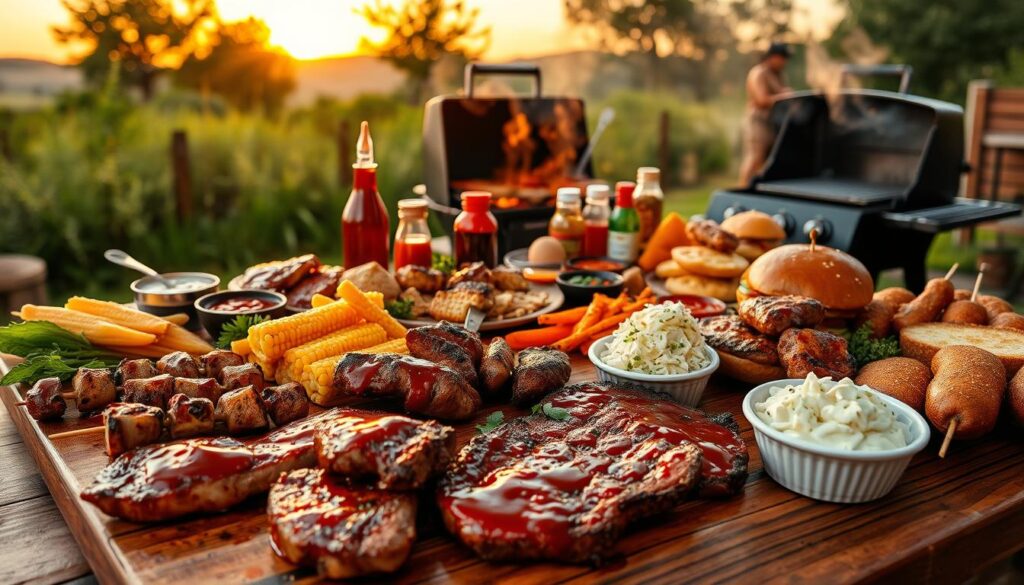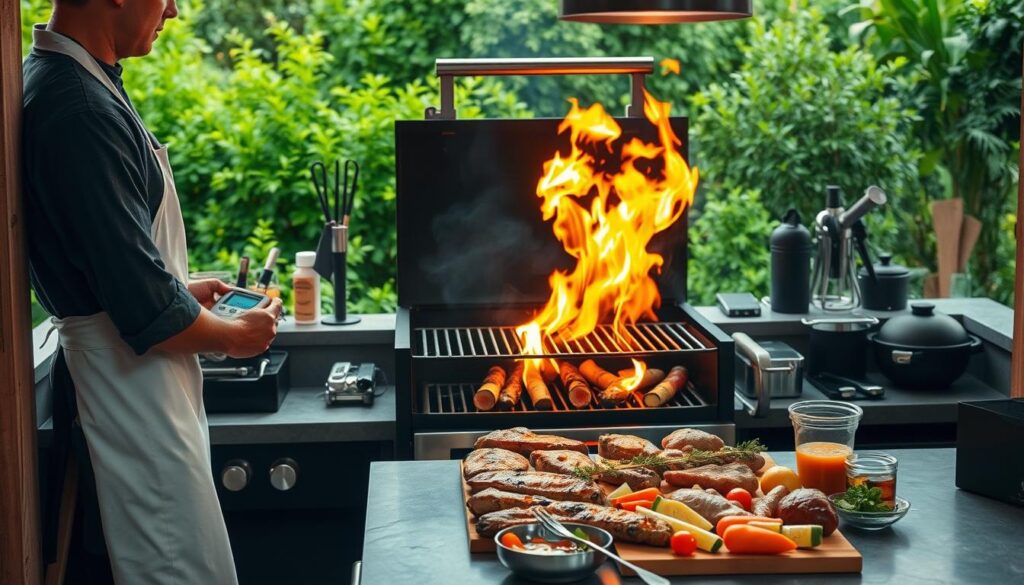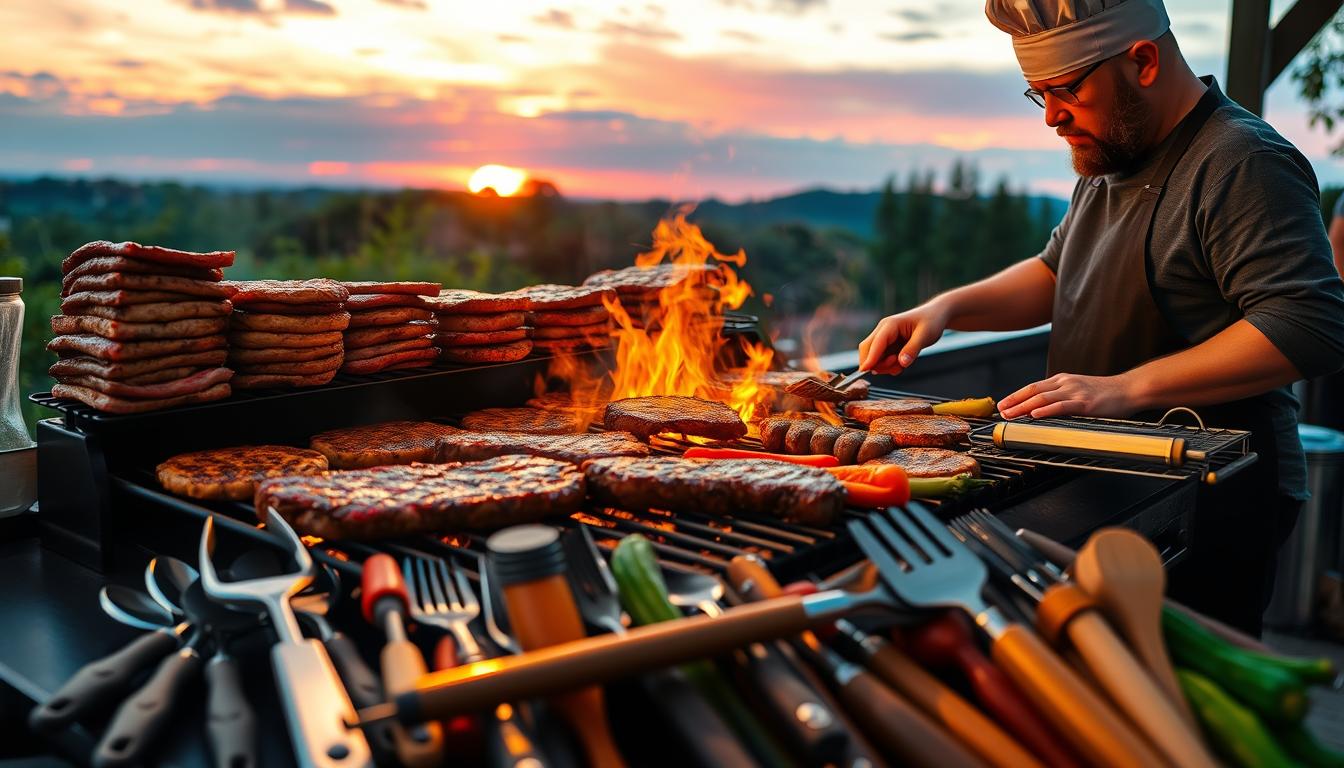We all love cooking outdoors, and grilling is a big part of it. With the right tips, anyone can become a master griller. About 30% of grillers prefer charcoal grills for their flavor. On the other hand, 40% choose gas grills for their convenience and control over temperature.
Electric grills, including Pellet Grills, are also popular, making up about 15% of the market. They are favored by urban dwellers. Grilling is a year-round activity for enthusiasts. We start preparing for grilling season as soon as the weather gets warmer.
The average grilling session lasts about 45 minutes. With optimal preheating time, we can achieve perfect results. We will explore various grilling techniques, including direct and indirect grilling. This will help you improve your outdoor cooking skills and become a Grill Master.
By mastering different grilling techniques, we can cook a variety of dishes to perfection. Whether we prefer gas or charcoal grills, the key to successful grilling is understanding the basics of outdoor cooking. With practice and patience, we can achieve delicious results and impress our friends and family with our grilling skills.
Key Takeaways
- Charcoal grills are preferred by 30% of grillers for their flavor.
- Gas grills are the most popular choice, accounting for 40% of the market.
- Electric grills, including Pellet Grills, make up about 15% of the grilling market.
- Grilling meat to the correct internal temperature is critical for food safety.
- Marinating meat can reduce the formation of harmful compounds by up to 50% when grilling at high temperatures.
- Average grilling session lasts about 45 minutes, with optimal preheating time being around 10-15 minutes.
Understanding the Basics of Grilling
Grilling is more than just BBQ recipes and dinner ideas. It’s a cooking method that keeps the mess outside and doesn’t heat up the house. Plus, it makes food taste amazing, and we can grill almost anything.
To start, we need the right equipment. This includes grills, smokers, and utensils. There are gas, charcoal, and electric options, each with its own pros and cons. We should pick what works best for us.
Grilling safely is key. We must maintain our grills, handle food safely, and watch out for flare-ups. Knowing the basics helps us make tasty BBQ recipes and dinner ideas for everyone to enjoy.
Grilling Equipment We Need
We’ll need a grill, utensils, and more to begin. The grill type depends on what we like to cook and our personal taste.
Types of Grills and Smokers
There are many grills and smokers out there. Gas, charcoal, and electric are the main types. Each has its own benefits and drawbacks, so we should choose wisely.
Safety Tips for Grilling
Grilling can be fun, but safety comes first. We must keep our grills in good shape, handle food right, and watch for flare-ups. Following these tips keeps us safe and ensures a great grilling experience.
Preparing for a Successful Grill Session
When we start grilling, getting ready is key. We need to pick the right meat, marinate and season it, and have the right tools. Knowing the basics of grilling techniques is important. We must think about the grill type, heat levels, and cooking time for each meat.
To grill well, keep the grill grate clean to avoid sticking. Make sure to prepare and heat the grill before cooking. Also, watch your food closely to prevent overcooking or burning. These outdoor cooking tips help us cook perfect meals every time.
Important grilling tools include tongs, spatulas, and grill brushes. These tools help us grill more efficiently and safely. It’s also important to choose the right fuel, whether charcoal or gas, and keep the temperature right. By learning these grilling techniques and outdoor cooking tips, we can become grill masters and enjoy tasty meals with our loved ones.
- Choose the right cuts of meat for the type of grill and cooking method
- Marinate and season the meat to enhance flavor
- Keep the grill grate clean to prevent sticking
- Give yourself plenty of time to prepare and heat up the grill before cooking
- Keep an eye on what you’re grilling to avoid overcooking or burning
By following these tips and mastering grilling techniques and outdoor cooking tips, we can have a successful grill session. We’ll enjoy delicious meals all year round.
Mastering Different Grilling Techniques
Mastering various grilling techniques is key to making great BBQ dinner recipes. We need to know the difference between direct and indirect grilling. Direct grilling is best for searing meat to get a crispy outside. Indirect grilling is better for cooking bigger cuts of meat or delicate foods like fish and veggies.
Popular grilling methods include direct and indirect charcoal grilling. To do these right, we must know the right temperatures and cooking times. For example, indirect grilling works best at 225 to 275°F. Searing needs temperatures of 450 to 550°F for the best results.
Direct vs. Indirect Grilling
Direct grilling is great for thinner meats like burgers, sausages, chicken breasts, and fish fillets. It’s also good for veggies like bell peppers, zucchini, and asparagus. Indirect grilling is better for bigger cuts of meat, poultry, and delicate foods that need slow cooking without direct flame.

How to Perfectly Sear Meat
To sear meat perfectly, we need a high temperature, between 450 to 550°F. We can use reverse searing, starting with low-temperature cooking then finishing with a high-heat sear. This method is perfect for thicker meats like prime rib and beef tenderloin.
Creative Grilling Techniques We Can Try
We can try rotisserie grilling for even cooking at temperatures between 325 to 375°F. We can also play with marinades and seasonings to add flavor to our BBQ dinner recipes.
| Grilling Technique | Temperature Range | Cooking Time |
|---|---|---|
| Direct Grilling | 450-550°F | 1-2 minutes per side |
| Indirect Grilling | 225-275°F | 30 minutes to several hours |
| Reverse Searing | 225-275°F (low-temperature cooking), 450-550°F (high-heat sear) | 1-2 hours (low-temperature cooking), 1-2 minutes per side (high-heat sear) |
Grilling Vegetables and Fruits
Grilling veggies and fruits needs the right tips for perfect results. Cut veggies into wedges or cubes and rub with oil to prevent sticking. Grill them at 400 to 425°F (medium-high heat).
Some veggies like parsnips and carrots need a head start. Par-cook them in boiling water for 3 to 5 minutes. Cabbage and butternut squash should marinate in olive oil, lemon juice, and herbs for at least 15 minutes. Here are some grilling times to keep in mind:
- 4 to 6 minutes for tomatoes, spring onions, Romaine lettuce (whole head), and asparagus
- 7 to 8 minutes for summer squash, zucchini, eggplant, whole field carrots, cauliflower “steaks,” and small mushrooms
- 8 to 10 minutes for whole onions, bell peppers, artichokes, and okra pods
- 10 to 14 minutes for portabello mushroom caps and corn on the cob
By using these tips, we can make tasty grilled veggies and fruits. Always preheat the grill and clean the grate. Use a grill basket for small veggies to keep them from falling.
| Vegetable | Grilling Time | Temperature |
|---|---|---|
| Tomatoes | 4-6 minutes | 400-425°F |
| Summer Squash | 7-8 minutes | 400-425°F |
| Portabello Mushrooms | 10-14 minutes | 400-425°F |
The Art of BBQ Sauces and Rubs
BBQ recipes shine with the right sauce and rub. The $1 billion BBQ industry in the U.S. shows how much people love it. To make dinner ideas stand out, we must learn about BBQ sauces and rubs.
A great BBQ sauce can transform any dish. A well-made rub adds depth and complexity. Home grillers prefer homemade sauces and rubs over store-bought ones. This is because homemade options can be customized to taste.
Crafting Our Own BBQ Sauce
Making our own BBQ sauce is simple. With just a few ingredients, we can create a unique sauce. A typical BBQ sauce recipe has 10 to 12 ingredients, like ketchup, vinegar, and spices. By mixing different ingredients, we can find the perfect sauce for our BBQ favorites.
Essential Dry Rub Recipes
Dry rubs are key to BBQ recipes. By mixing spices and herbs, we can add flavor and texture. Classic rubs include paprika, garlic powder, and onion powder. Spicy rubs mix chili powder, cumin, and coriander.
| BBQ Sauce Type | Ingredients | Pairing Suggestions |
|---|---|---|
| Kansas City-style | Ketchup, vinegar, brown sugar | Beef, pork, chicken |
| Carolina-style | Vinegar, mustard, spices | Pork, chicken, vegetables |
| Texas-style | Beef broth, chili powder, cumin | Beef, sausage, vegetables |
Mastering BBQ sauces and rubs elevates our dinner ideas. Whether grilling burgers, steaks, or veggies, the right sauce and rub matter. So, let’s experiment with BBQ recipes and techniques. With practice, we can become BBQ experts and impress our loved ones.
Timing and Temperature Control
Timing and temperature control are key to grilling meats perfectly. In outdoor cooking, using a meat thermometer is vital. It helps keep the meat juicy and tender.
To get great results, know the temperature ranges and cook times. For instance, chicken breasts need to be at 165-170°F (74-77°C) at 350°F (176°C). Steak, on the other hand, can be medium-rare at 400°F (204°C) in about 10 minutes.
Here are some general guidelines for cooking different types of meat:
- Chicken: 165-170°F (74-77°C) at 350°F (176°C) for 12-16 minutes
- Steak: 130-165°F (55-74°C) at 400°F (204°C) for 10-17 minutes
- Pork: 145°F (63°C) at 325-350°F (163-176°C) for 10-20 minutes

Follow these guidelines and use a meat thermometer for perfect results. Always prioritize food safety and use proper grilling techniques. This way, you avoid undercooking or overcooking your meat.
| Meat Type | Internal Temperature | Grill Temperature | Cook Time |
|---|---|---|---|
| Chicken Breast | 165-170°F (74-77°C) | 350°F (176°C) | 12-16 minutes |
| Steak | 130-165°F (55-74°C) | 400°F (204°C) | 10-17 minutes |
| Pork Chop | 145°F (63°C) | 325-350°F (163-176°C) | 10-20 minutes |
Serving and Plating for Presentation
When it comes to dinner ideas, presentation is key. A well-plated dish can make the dining experience better. A study by Professor Charles Spence found that presentation can make food taste 29% better. To enhance taste, we can use outdoor cooking tips like grilling and smoking.
To make our dishes look good, we can use colors and textures. For example, mixing grilled meats, roasted vegetables, and fresh herbs creates a colorful dish. Using different shapes and sizes of plates adds visual interest.
Here are some suggested side dishes for BBQ that can complement our grilled meats:
- Grilled vegetables such as asparagus, bell peppers, and zucchini
- Roasted potatoes and sweet potatoes
- Fresh salads with mixed greens, cherry tomatoes, and cucumber
For beverage pairings, we can choose drinks that complement our grilled food. Some options include:
- Iced tea with lemon and mint
- Fresh lemonade with a twist of citrus
- Cold beer with a hint of hops
By following these outdoor cooking tips and presentation techniques, we can create a memorable dining experience. Whether it’s a backyard BBQ or a formal dinner party, the key is to have fun and be creative.
| Food | Presentation Tips |
|---|---|
| Grilled Meats | Use a variety of colors and textures, and arrange food in a visually appealing way |
| Roasted Vegetables | Use different shapes and sizes of plates and bowls to add visual interest |
| Fresh Salads | Choose drinks that complement the flavors of our grilled food |
Troubleshooting Common Grilling Issues
Grilling can sometimes go wrong, leading to undercooked, burnt, or flare-up problems. To fix these issues, we can use some easy tips. For example, trimming fat from meat before grilling can stop flare-ups. Also, a meat thermometer helps cook meat to the right temperature.
Other helpful tips include cleaning the grill grates before cooking. This reduces sticking and boosts flavor. Using wood chips can also add a smoky taste to grilled meats. By following these tips, we can grill without stress and get delicious results every time.
- Undercooking: Use a meat thermometer to ensure the meat is cooked to the perfect temperature.
- Burning: Keep an eye on the heat and adjust as needed to prevent burning.
- Flare-ups: Trim excess fat from meat before cooking and keep a fire extinguisher nearby.
| Grilling Issue | Solution |
|---|---|
| Undercooking | Use a meat thermometer |
| Burning | Adjust heat as needed |
| Flare-ups | Trim excess fat and keep a fire extinguisher nearby |
Cleaning and Maintaining Our Grill
Keeping our outdoor grill clean is key to enjoying great BBQ for years. By following some simple outdoor cooking tips, we can keep our grill in top shape. This ensures it works well every time we use it.
Regular cleaning is vital to make our grill last longer. A quick clean after each use and deeper cleans every few months help. They improve food taste, cut down on flare-ups, and can extend the grill’s life by up to 50%. Using good cleaning tools, like a strong wire brush, makes cleaning easier.
Using a weatherproof cover to protect our grill is also important. It cuts down on damage from the weather by up to 80%, helping our grill last longer. Following the maker’s care and storage tips keeps our grill in great shape all year.
By focusing on outdoor cooking tips and regular upkeep, our grill will be ready for many BBQs. A bit of effort means we can enjoy perfectly grilled food for years.

